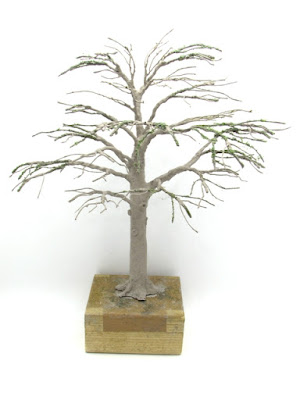Railway modelling in 7mm scale on 9mm gauge track, representing 15" gauge miniature railways and 18" gauge industrial railways. (Plus anything else that I choose to include!)
Sunday, 24 April 2022
Finished Business - a 15" Workhorse
Thursday, 21 April 2022
Tree One - Completed
I do rather like that gap through the leaves where the big branch is exposed. I may have to consider adding wildlife of some sort here, maybe a couple of birds or even a squirrel. By some unplanned act this same area is actually visible from above too.
I'm rather pleased with it, I was asked by family how long it all took, and I have no idea, but somewhere between 10-20 hours would be right including the original frame creation last year. Unlike the original build that lived on a shelf in the workshop, the Mk2 version has been swiftly placed in an adapted box ready for future use.
As for 'Tree two', that may have to wait until the layout progresses and the foliage is restocked!
Colin
Saturday, 16 April 2022
Tree Painting and Foliage
- Overall wash of Citadel 'Nuln Oil', with a spot of water added in places to help it spread out. This darkened the tree to a dark grey, and was left to dry overnight.
- A misting of Humbrol dark brown (29) from an aerosol, this isn't that dark, but a misting adds a nice beige effect to the mix.
- Dry brushing with a mix of Vallejo colours, notably grey-green, London grey and WW1 beige. This varied in different areas of the trunk and branches.
- Stippling with a stiff brush and the colours above, especially on the smoother branches to give an effect of texture.
- More stippling concentrating grey-green and additionally yellow and off-white into those areas that might have a high traffic of birdlife, creating the effect of moss and guano!
The next step was to start to think about adding foliage, where I felt that I would need to improve on the original to add more depth to it. The original had used Hornby Skale Scenics mid-green foliage and despite having removed this for reuse the stiffness it now has from hairspray meant that it would not be reusable on this tree. New material from the same pack was used but having got around several of the lower branches I was not too happy with the result, feeling it looked too flat and matted. I ended up taking it back off again and having a rethink.
Saturday, 9 April 2022
Tree Construction Continues
I'm making progress with the half-relief tree. I've bulked up the trunk using DAS Stone modelling clay, I still need to adjust the branches and then apply bark mix all over the exposed bits of wire frame to match the existing, and also to cover the DAS.














